Sustainability through the Digitalization of Industrial Machines: Complementary Factors of Fuel Consumption and Productivity for Forklifts with Sensors
Abstract
1. Introduction
2. Related Work
3. Method
3.1. Sample and Data Collection
3.2. Data Preparation and Analysis
4. Results
4.1. Prediction Ability
4.2. Key Determinants of Fuel Consumption and Productivity
5. Discussion
6. Conclusions
Author Contributions
Funding
Conflicts of Interest
Appendix A
| Variables | Unit of Measurement | Description | Mean | Standard Deviation |
|---|---|---|---|---|
| Counters | ||||
| Distance forward | km | Total distance forward covered by a vehicle during a specific time period | 24.463 | 20.707 |
| Distance in reverse | km | Total distance in reverse covered by a vehicle during a specific time period | 5.333 | 6.412 |
| Total distance | km | Total distance covered by a vehicle during a specific time period | 29.796 | 24.230 |
| Idle occurrences | number | Number of times when a vehicle has been idling without performing/producing | 8.310 | 8.867 |
| Shock occurrences | number | Number of shocks (hard braking, crashing into the bumper, crossing a railway, and any other jarring events) experienced by a vehicle | 58.240 | 102.521 |
| Number of overloads | number | Number of times a vehicle lifted more than its rated capacity | 15.250 | 49.380 |
| Total weight | ton | Total number of tons being lifted by a vehicle during a specific time period | 660.731 | 727.788 |
| Total loads lifted | number | Number of loads lifted by a vehicle during a specific time period | 175.850 | 172.781 |
| Speed average | km/h | The average speed a vehicle achieves during a given time period | 6.623 | 3.161 |
| Speed maximum | km/h | The maximum speed of a vehicle within a set time period | 20.320 | 6.763 |
| Diesel level maximum | % | The filling levels of diesel fuel | 84.910 | 22.906 |
| Battery voltage | V | The voltage of the battery | 17.188 | 12.718 |
| Time | ||||
| Driving time | hour | Total number of hours a vehicle is driven (speed greater than 0) | 5.273 | 3.778 |
| Hydraulic time | hour | Total hours of hydraulic function use | 2.540 | 2.004 |
| Idling time | hour | Time the engine is running but the vehicle is not moving or using load handling functions | 4.102 | 3.519 |
| Engine time | hour | Time the engine is running when vehicle is moving or using load handling functions | 9.509 | 6.660 |
| Time in ECO mode | hour | Time the vehicle has been driving in Eco driving mode | 0.919 | 0.925 |
| Time in Normal mode | hour | Time the vehicle has been driving in Normal driving mode | 1.814 | 1.298 |
| Time in Power mode | hour | Time the vehicle has been driving in Power driving mode | 2.239 | 1.560 |
| Production time | hour | Engine time minus idle time | 5.408 | 3.936 |
| Time in overload | hour | Time during which a vehicle carried a very heavy load | 0.187 | 0.750 |
| Load spectra (time) | ||||
| Load spectrum 0–10percentage time | hour | Time during which a vehicle operated in load spectrum 0–10 | 2.517 | 2.418 |
| Load spectrum 11–20percentage time | hour | Time during which a vehicle operated in load spectrum 11–20 | 0.488 | 0.582 |
| Load spectrum 21–30percentage time | hour | Time during which a vehicle operated in load spectrum 21–30 | 0.571 | 0.814 |
| Load spectrum 31–40percentage time | hour | Time during which a vehicle operated in load spectrum 31–40 | 0.444 | 0.687 |
| Load spectrum 41–50percentage time | hour | Time during which a vehicle operated in load spectrum 41–50 | 0.288 | 0.383 |
| Load spectrum 51–60percentage time | hour | Time during which a vehicle operated in load spectrum 51–60 | 0.238 | 0.369 |
| Load spectrum 71–80percentage time | hour | Time during which a vehicle operated in load spectrum 71–80 | 0.132 | 0.264 |
| Load spectrum 81–90percetage time | hour | Time during which a vehicle operated in load spectrum 81–90 | 0.094 | 0.271 |
| Load spectrum 91–100percentage time | hour | Time during which a vehicle operated in load spectrum 91–100 | 0.063 | 0.193 |
| Load spectrum above 101percentage time | hour | Time during which a vehicle operated in load spectrum above 100 | 0.255 | 0.524 |
| Load Spectra (Number of Lifts) | ||||
| Load spectrum 0–10percentage counter | number | Number of lifts in load spectrum 0–10 | 36.670 | 48.323 |
| Load spectrum 11–20 percentage counter | number | Number of lifts in load spectrum 11–20 | 31.755 | 41.679 |
| Load spectrum 21–30percentage counter | number | Number of lifts in load spectrum 21–30 | 27.693 | 37.146 |
| Load spectrum 31–40percentage counter | number | Number of lifts in load spectrum 31–40 | 18.240 | 25.740 |
| Load spectrum 41–50percentage counter | number | Number of lifts in load spectrum 41–50 | 13.190 | 24.116 |
| Load spectrum 51–60percentage counter | number | Number of lifts in load spectrum 51–60 | 9.833 | 17.099 |
| Load spectrum 61–70percentage counter | number | Number of lifts in load spectrum 61–70 | 7.676 | 15.649 |
| Load spectrum 71–80percentage counter | number | Number of lifts in load spectrum 71–80 | 4.699 | 10.615 |
| Load spectrum 81–90percentage counter | number | Number of lifts in load spectrum 81–90 | 2.34 | 7.699 |
| Temperature | ||||
| Ambient temperature minimum | °C | Minimum ambient temperature during a given time period | 10.940 | 8.045 |
| Ambient temperature maximum | °C | Maximum ambient temperature during a given time period | 20.770 | 9.290 |
| Ambient temperature average | °C | Average ambient temperature during a given time period | 16.190 | 8.371 |
| Engine coolant temperature average | °C | Average engine coolant temperature during a given time period | 78.312 | 11.117 |
| Hydraulic temperature average | °C | Average hydraulic temperature average during a given time period | 44.889 | 13.079 |
| Transmission oil temperature average | °C | Average transmission oil temperature during a given time period | 63.907 | 12.515 |
| Fuel-related Variables Per Time Unit | ||||
| Fuel used | Liter/day | The amount of fuel consumed by a vehicle during a specific time period (per day) | 65.409 | 47.196 |
| Fuel used per hour | Liter/hour | Average fuel consumption per engine hour | 7.031 | 2.391 |
| Fuel used per load | Liter/load | Average fuel consumption per load | 1.604 | 7.398 |
| Fuel used per ton | Liter/ton | Average fuel consumption per ton | 0.691 | 4.925 |
| Fuel used per ton-meter | Liter/ton-meter | Average fuel consumption per ton-meter | 0.0216 | 0.264 |
Appendix B
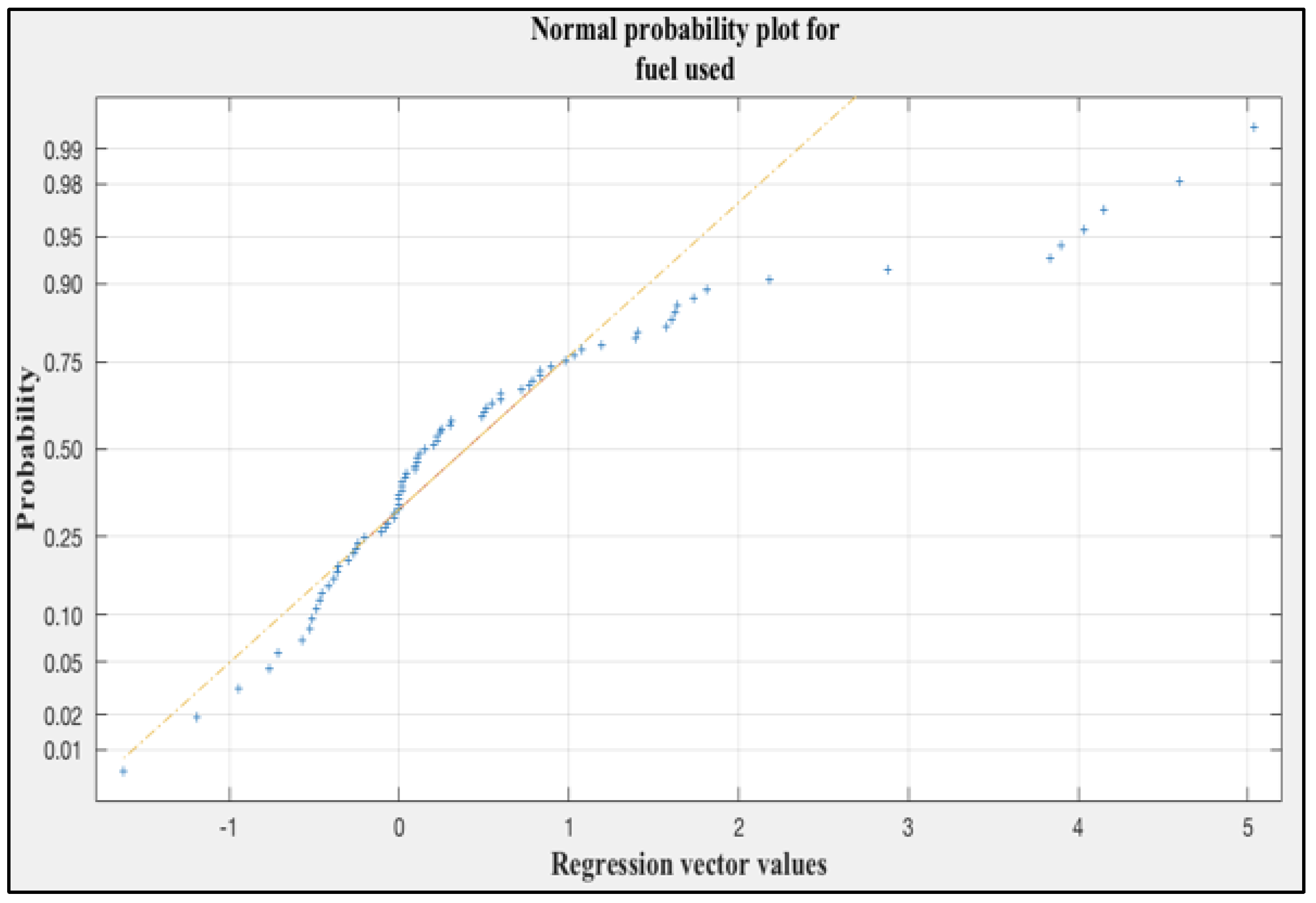
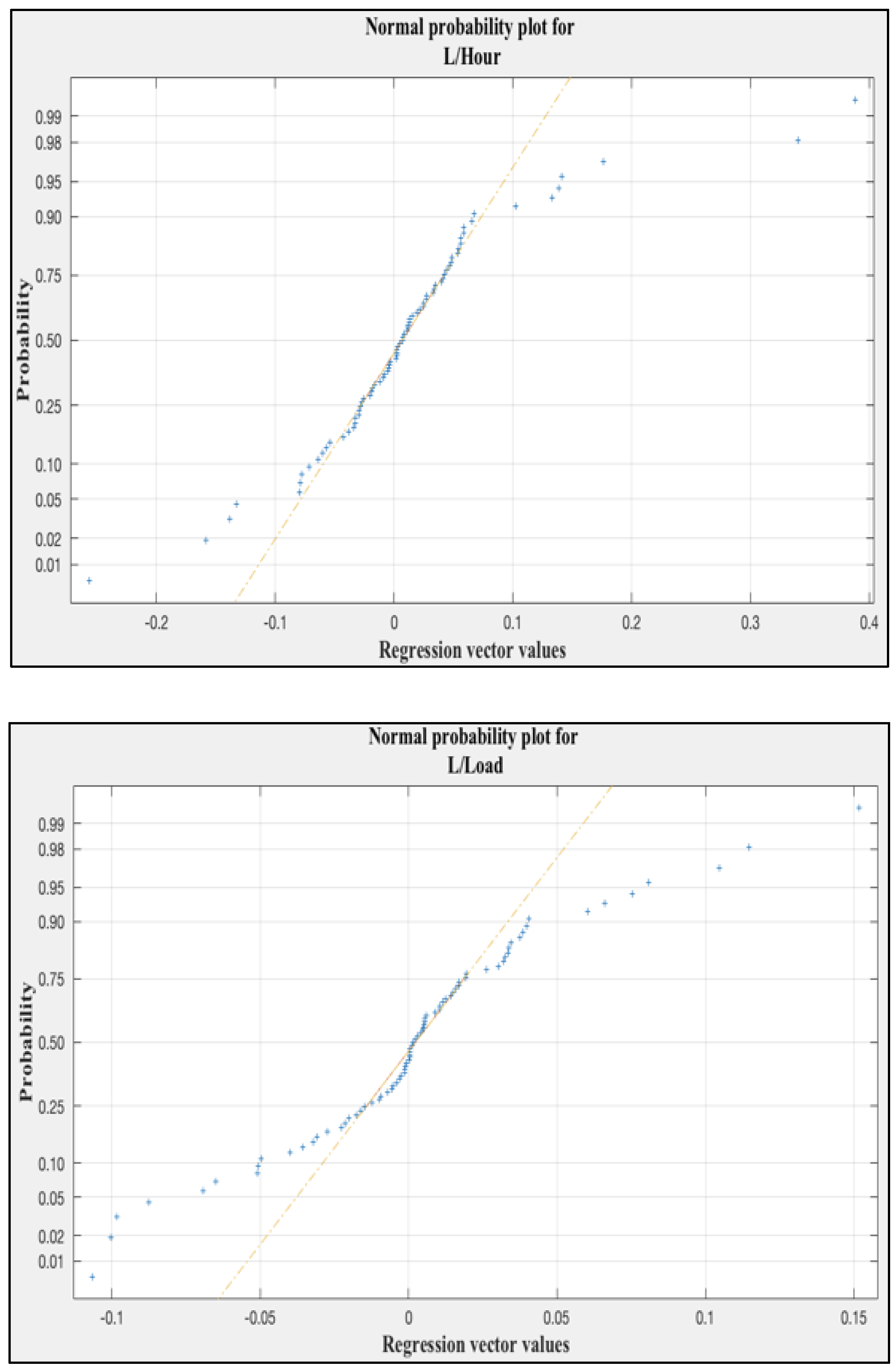
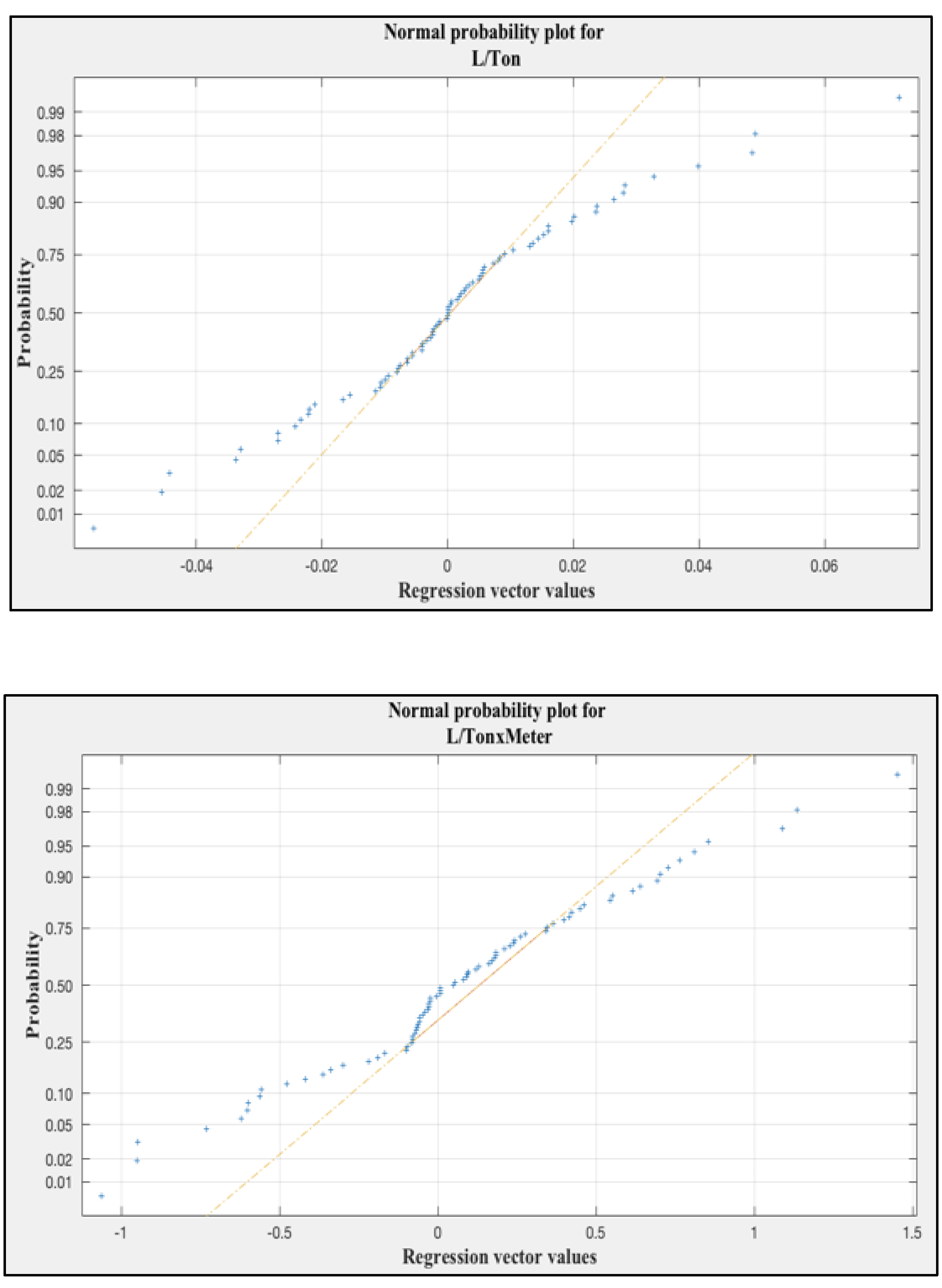
Appendix C
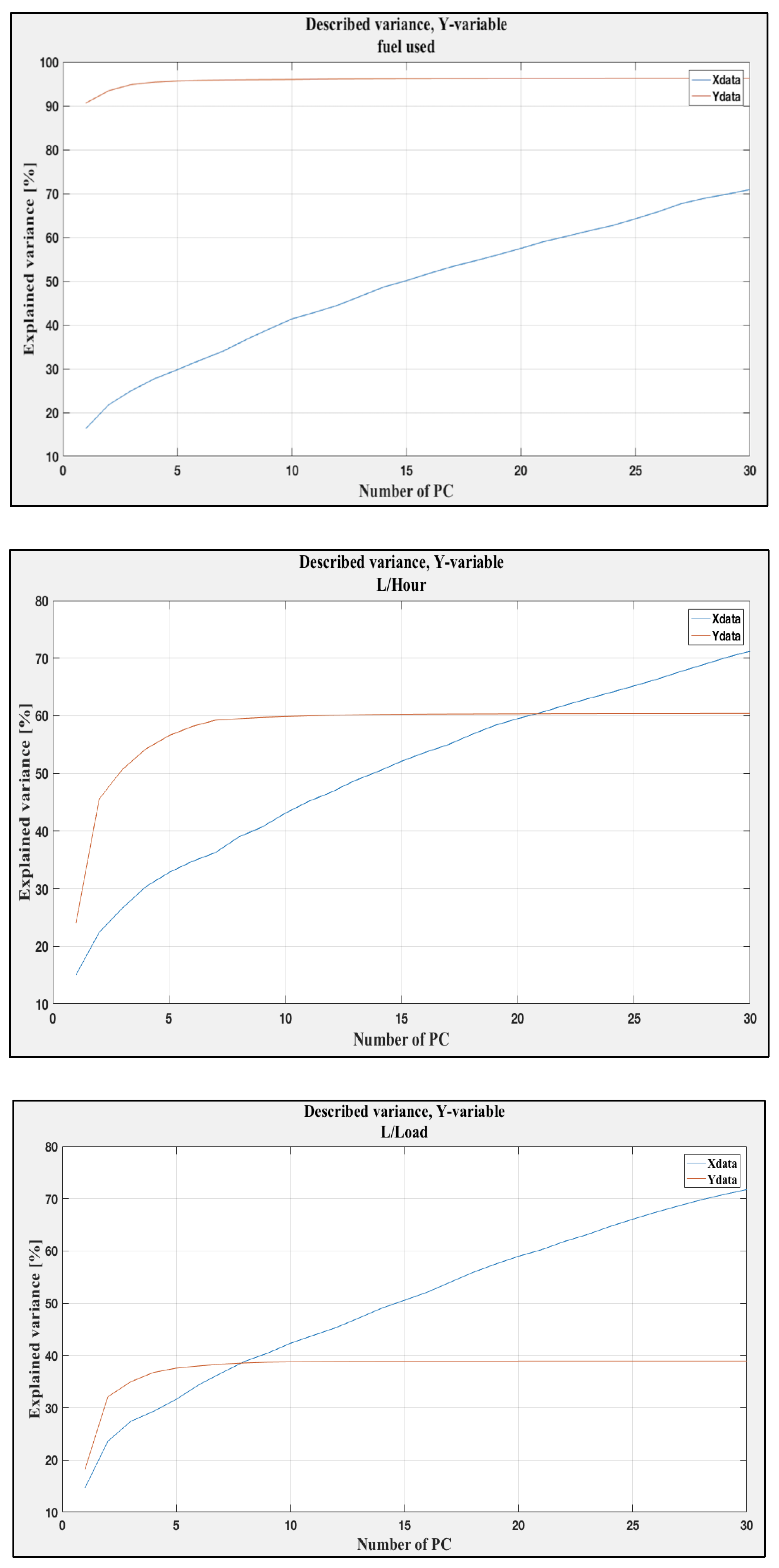
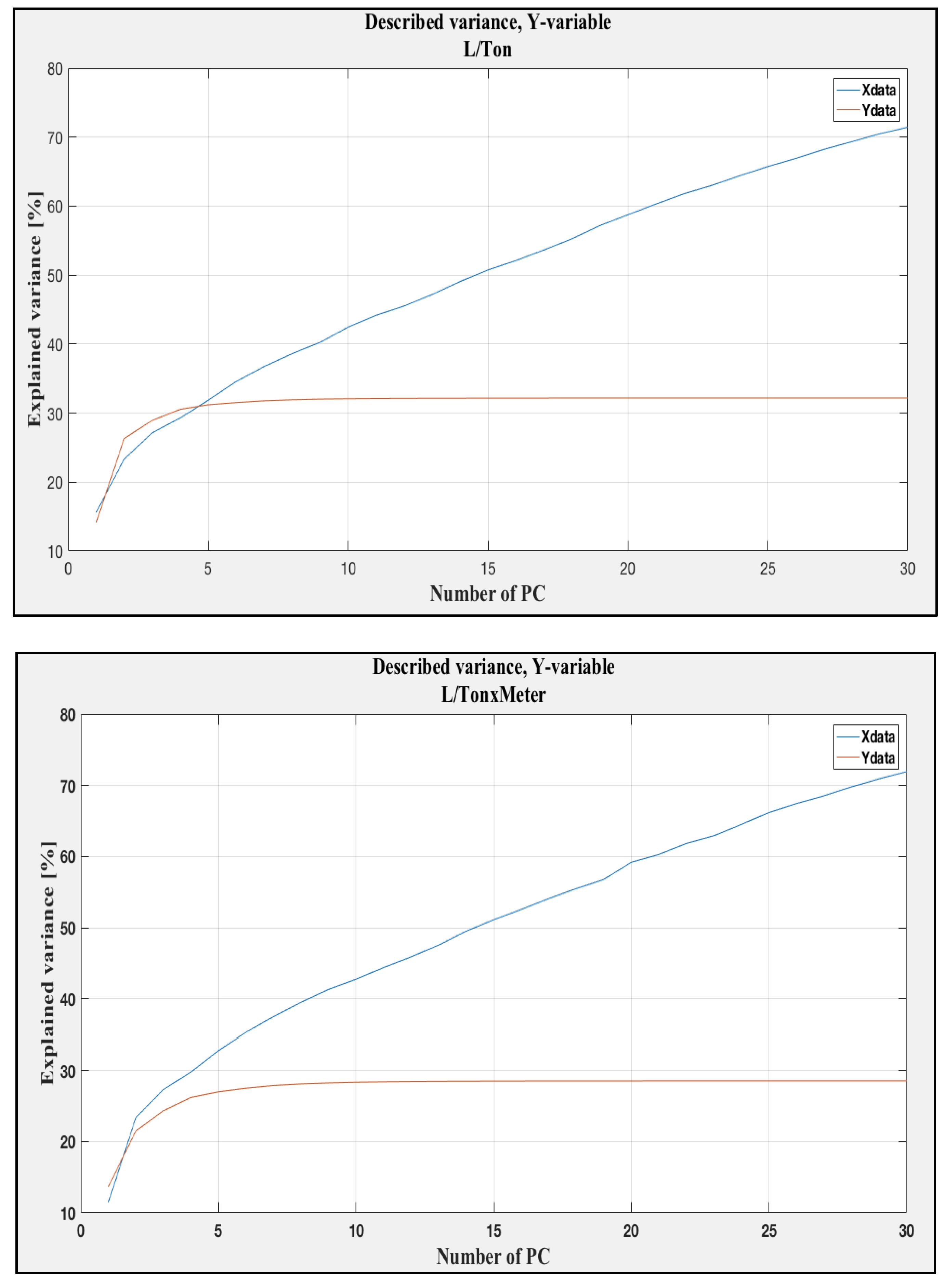
References
- Ng, F.; Harding, J.A.; Glass, J. An eco-approach to optimise efficiency and productivity of a hydraulic excavator. J. Clean. Prod. 2016, 112, 3966–3976. [Google Scholar] [CrossRef]
- Reşitoğlu, İ.A.; Altinişik, K.; Keskin, A. The pollutant emissions from diesel-engine vehicles and exhaust aftertreatment systems. Clean Technol. Environ. Policy 2015, 17, 15–27. [Google Scholar] [CrossRef]
- Zhang, Y.; Yao, Z.; Shen, X.; Liu, H.; He, K. Chemical characterization of PM2.5 emitted from on-road heavy-duty diesel trucks in China. Atmos. Environ. 2015, 122, 885–891. [Google Scholar] [CrossRef]
- Tucki, K.; Mruk, R.; Orynycz, O.; Botwińska, K.; Gola, A.; Bączyk, A. Toxicity of exhaust fumes (CO, NOx) of the compression-ignition (diesel) engine with the use of simulation. Sustainability 2019, 11, 2188. [Google Scholar] [CrossRef]
- Gola, A.; Kłosowski, G. Development of computer-controlled material handling model by means of fuzzy logic and genetic algorithms. Neurocomputing 2019, 338, 381–392. [Google Scholar] [CrossRef]
- Lewis, P.; Fitriani, H.; Arocho, I. Engine variable impact analysis of fuel use and emissions for heavy-duty diesel maintenance equipment. Transp. Res. Rec. 2015, 2482, 8–15. [Google Scholar] [CrossRef]
- Lewis, P.; Rasdorf, W. Fuel use and pollutant emissions taxonomy for heavy duty diesel construction equipment. J. Manag. Eng. 2016, 33, 04016038. [Google Scholar] [CrossRef]
- Song, M.; Wu, N.; Wu, K. Energy consumption and energy efficiency of the transportation sector in Shanghai. Sustainability 2014, 6, 702–717. [Google Scholar] [CrossRef]
- Osorio-Tejada, J.L.; Llera-Sastresa, E.; Hashim, A.H. Well-to-wheels approach for the environmental impact assessment of road freight services. Sustainability 2018, 10, 4487. [Google Scholar] [CrossRef]
- Huo, H.; Yao, Z.; Zhang, Y.; Shen, X.; Zhang, Q.; He, K. On-board measurements of emissions from diesel trucks in five cities in China. Atmos. Environ. 2012, 54, 159–167. [Google Scholar] [CrossRef]
- Harris, I.; Wang, Y.; Wang, H. ICT in multimodal transport and technological trends: Unleashing potential for the future. Int. J. Prod. Econ. 2015, 159, 88–103. [Google Scholar] [CrossRef]
- Leviäkangas, P. Digitalization of Finland’s transport sector. Technol. Soc. 2016, 47, 1–15. [Google Scholar] [CrossRef]
- Kan, Z.; Tang, L.; Kwan, M.P.; Zhang, X. Estimating vehicle fuel consumption and emissions using GPS big data. Int. J. Environ. Res. Public Health 2018, 15, 566. [Google Scholar] [CrossRef]
- Cho, W.; Choi, E. DTG Big data analysis for fuel consumption estimation. J. Inf. Process. Syst. 2017, 13, 285–304. [Google Scholar]
- Holzleitner, F.; Kanzian, C.; Stampfer, K. Analyzing time and fuel consumption in road transport of round wood with an onboard fleet manager. Eur. J. For. Res. 2011, 130, 293–301. [Google Scholar] [CrossRef]
- McGordon, A.; Poxon, J.E.; Cheng, C.; Jones, R.P.; Jennings, P.A. Development of a Driver Model to Study the Effects of Real-World Driver Behaviour on the Fuel Consumption. Proc. Inst. Mech. Eng. Part D J. Automob. Eng. 2011, 225, 1518–1530. [Google Scholar] [CrossRef]
- Demir, E.; Bektaş, T.; Laporte, G. A review of recent research on green road freight transportation. Eur. J. Oper. Res. 2014, 237, 775–793. [Google Scholar] [CrossRef]
- Li, Y.; Yu, Y. The use of freight apps in road freight transport for CO2 reduction. Eur. Transp. Res. Rev. 2017, 9, 36. [Google Scholar] [CrossRef]
- Boenzi, F.; Digiesi, S.; Facchini, F.; Mossa, G.; Mummolo, G. Sustainable Warehouse Logistics: A NIP Model for Non-Road Vehicles and Storage Configuration Selection. In Proceedings of the XX Summer School “Francesco Turco—Operational, Excellence, Experiences”, Naples, Italy, 16–18 September 2015; pp. 263–270. [Google Scholar]
- Boenzi, F.; Digiesi, S.; Facchini, F.; Mummolo, G. Electric and LPG Forklifts GHG Assessment in Material Handling Activities in Actual Operational Conditions. In Proceedings of the IEEE International Conference on Service Operations and Logistics, and Informatics, Bari, Italy, 18–20 September 2017; pp. 127–132. [Google Scholar]
- Roodbergen, K.J. Storage assignment for order picking in multiple-block warehouses. In Warehousing in the Global Supply Chain; Springer: London, UK, 2012; pp. 139–155. [Google Scholar]
- Gademann, N.; Velde, S. Order batching to minimize total travel time in a parallel-aisle warehouse. IIE Trans. 2005, 37, 63–75. [Google Scholar] [CrossRef]
- Facchini, F.; Mummolo, G.; Mossa, G.; Digiesi, S.; Boenzi, F.; Verriello, R. Minimizing the carbon footprint of material handling equipment: Comparison of electric and LPG forklifts. J. Ind. Eng. Manag. (JIEM) 2016, 9, 1035–1046. [Google Scholar] [CrossRef]
- Al-Shaebia, A.; Khader, N.; Daoud, H.; Weiss, J.; Won Yoon, S. The effect of forklift driver behavior on energy consumption and productivity. Procedia Manuf. 2017, 11, 778–786. [Google Scholar] [CrossRef]
- Günther, W.A.; Mehrizi, M.H.R.; Huysman, M.; Feldberg, F. Debating big data: A literature review on realizing value from big data. J. Strateg. Inf. Syst. 2017, 26, 191–209. [Google Scholar] [CrossRef]
- Hopkins, J.; Hawking, P. Big data analytics and IoT in logistics: A case study. Int. J. Logist. Manag. 2018, 29, 575–591. [Google Scholar] [CrossRef]
- Mikalef, P.; Pappas, I.O.; Krogstie, J.; Giannakos, M. Big data analytics capabilities: A systematic literature review and research agenda. Inf. Syst. E-Bus. Manag. 2018, 16, 547–578. [Google Scholar] [CrossRef]
- Sivarajah, U.; Kamal, M.M.; Irani, Z.; Weerakkody, V. Critical analysis of Big Data challenges and analytical methods. J. Bus. Res. 2017, 70, 263–286. [Google Scholar] [CrossRef]
- Kecojevic, V.; Komljenovic, D. Haul truck fuel consumption and CO2 emission under various engine load conditions. Min. Eng. 2010, 62, 44–48. [Google Scholar]
- Demir, E.; Bektaş, T.; Laporte, G. An adaptive large neighborhood search heuristic for the pollution-routing problem. Eur. J. Oper. Res. 2012, 2, 346–359. [Google Scholar] [CrossRef]
- Van Woensel, T.; Creten, R.; Vandaele, N. Managing the environmental externalities of traffic logistics: The issue of emissions. Prod. Oper. Manag. 2001, 10, 207–223. [Google Scholar] [CrossRef]
- Bektaş, T.; Laporte, G. The pollution-routing problem. Transp. Res. Part B Methodol. 2011, 45, 1232–1250. [Google Scholar] [CrossRef]
- Demir, E.; Bektaş, T.; Laporte, G. A comparative analysis of several vehicle emission models for road freight transportation. Transp. Res. Part D Transp. Environ. 2011, 16, 347–357. [Google Scholar] [CrossRef]
- El-Shawarby, I.; Ahn, K.; Rakha, H. Comparative field evaluation of vehicle cruise speed and acceleration level impacts on hot stabilized emissions. Transp. Res. Part D Transp. Environ. 2005, 10, 13–30. [Google Scholar] [CrossRef]
- Hari, D.; Brace, C.J.; Vagg, C.; Poxon, J.; Ash, L. Analysis of a Driver Behaviour Improvement Tool to Reduce Fuel Consumption. In Proceedings of the Connected Vehicles and Expo (ICCVE), 2012 International Conference, Beijing, China, 12–16 December 2012; pp. 208–213. [Google Scholar]
- Lárusdóttir, E.B.; Ulfarsson, G.F. Effect of driving behavior and vehicle characteristics on energy consumption of road vehicles running on alternative energy sources. Int. J. Sustain. Transp. 2015, 9, 592–601. [Google Scholar] [CrossRef]
- Zaabar, I.; Chatti, K. Calibration of HDM-4 models for estimating the effect of pavement roughness on fuel consumption for US conditions. Transp. Res. Rec. J. Transp. Res. Board 2010, 2155, 105–116. [Google Scholar] [CrossRef]
- Baumgartner, M.; Leonardi, L. Optimierte disposition und telematik steigern effizienz im deutschen SGV. Int. Verk. 2004, 56, 197–201. [Google Scholar]
- Leonardi, J.; Baumgartner, M. CO2 efficiency in road freight transportation: Status quo, measures and potential. Transp. Res. Part D Transp. Environ. 2004, 9, 451–464. [Google Scholar] [CrossRef]
- Baumgartner, M.; Léonardi, J.; Krusch, O. Improving computerized routing and scheduling and vehicle telematics: A qualitative survey. Transp. Res. Part D Transp. Environ. 2008, 13, 377–382. [Google Scholar] [CrossRef]
- Wang, Y.; Sanchez Rodrigues, V.; Evans, L. The use of ICT in road freight transport for CO2 reduction – An exploratory study of UK’s grocery retail industry. Int. J. Logist. Manag. 2015, 26, 2–29. [Google Scholar] [CrossRef]
- Agar, B.J.; Baetz, B.W.; Wilson, B.G. Fuel consumption, emissions estimation, and emissions cost estimates using global positioning data. J. Air Waste Manag. Assoc. 2007, 57, 348–354. [Google Scholar] [CrossRef]
- Hunt, S.W.; Odhams, A.M.C.; Roebuck, R.L.; Cebon, D. Parameter Measurement for Heavy-Vehicle Fuel Consumption Modelling. Proc. Inst. Mech. Eng. Part D 2011, 225, 567–589. [Google Scholar] [CrossRef]
- Grubinger, T.; Wickström, N.; Björklund, A.; Hellring, M. Knowledge extraction from real-world logged data. SAE Int. J. Commer. Veh. 2009, 2, 64–74. [Google Scholar] [CrossRef]
- Roberts, J. The Modern Firm: Organizational Design for Performance and Growth; Oxford University Press: Oxford, UK, 2007. [Google Scholar]
- Caraman, D.; Constantin, I. Sustainable transport. In Designing Mobility and Transport Services; Routledge: Abingdon, UK, 2016; pp. 37–46. [Google Scholar]
- Perego, A.; Perotti, S.; Mangiaracina, R. ICT for logistics and freight transportation: A literature review and research agenda. Int. J. Phys. Distrib. Logist. Manag. 2011, 41, 457–483. [Google Scholar] [CrossRef]
- Nguyen, H.O. Critical factors in e-business adoption: Evidence from Australian transport and logistics companies. Int. J. Prod. Econ. 2013, 146, 300–312. [Google Scholar] [CrossRef]
- Evangelista, P. Environmental sustainability practices in the transport and logistics service industry: An exploratory case study investigation. Res. Transp. Bus. Manag. 2014, 12, 63–72. [Google Scholar] [CrossRef]
- Evangelista, P.; Sweeney, E. Information and communication technology adoption in the Italian road freight haulage industry. Int. J. Logist. Syst. Manag. 2014, 19, 261–282. [Google Scholar] [CrossRef]
- Cramer, R.D.; Bunce, J.D.; Patterson, D.E.; Frank, I.E. Cross validation, bootstrapping, and partial least squares compared with multiple regression in conventional QSAR studies. Quant. Struct. Act. Relatsh. 1988, 7, 18–25. [Google Scholar] [CrossRef]
- Peng, D.X.; Lai, F. Using partial least squares in operations management research: A practical guideline and summary of past research. J. Oper. Manag. 2012, 30, 467–480. [Google Scholar] [CrossRef]
- Dindarloo, S.R.; Siami-Irdemoosa, E. Determinants of fuel consumption in mining trucks. Energy 2016, 112, 232–240. [Google Scholar] [CrossRef]
- Wang, T.; Li, H.; Zhang, J.; Lu, Y. Influencing factors of carbon emission in China’s road freight transport. Procedia-Soc. Behav. Sci. 2012, 43, 54–64. [Google Scholar] [CrossRef]
- Zhang, M.; Mu, H.; Li, G.; Ning, Y. Forecasting the transport energy demand based on PLSR method in China. Energy 2009, 34, 1396–1400. [Google Scholar] [CrossRef]
- Mevik, B.-H.; Wehrens, R. The PLS package: Principal component and partial least squares regression in R. J. Stat. Softw. 2007, 18, 1–23. [Google Scholar] [CrossRef]
- Wold, S.; Sjöström, M.; Eriksson, L. PLS-regression: A basic tool of chemometrics. Chemom. Intell. Lab. Syst. 2001, 58, 109–130. [Google Scholar] [CrossRef]
- Esposito Vinzi, V.; Chin, W.W.; Henseler, J.; Wang, H. Handbook of Partial Least Squares: Concepts, Methods and Applications; Springer: Heidelberg, Germany; Dordrecht, The Netherlands; London, UK; New York, NY, USA, 2010. [Google Scholar]
- Ennen, E.; Richter, A. The whole is more than the sum of its parts—Or is it? A review of the empirical literature on complementarities in organizations. J. Manag. 2010, 36, 207–233. [Google Scholar] [CrossRef]

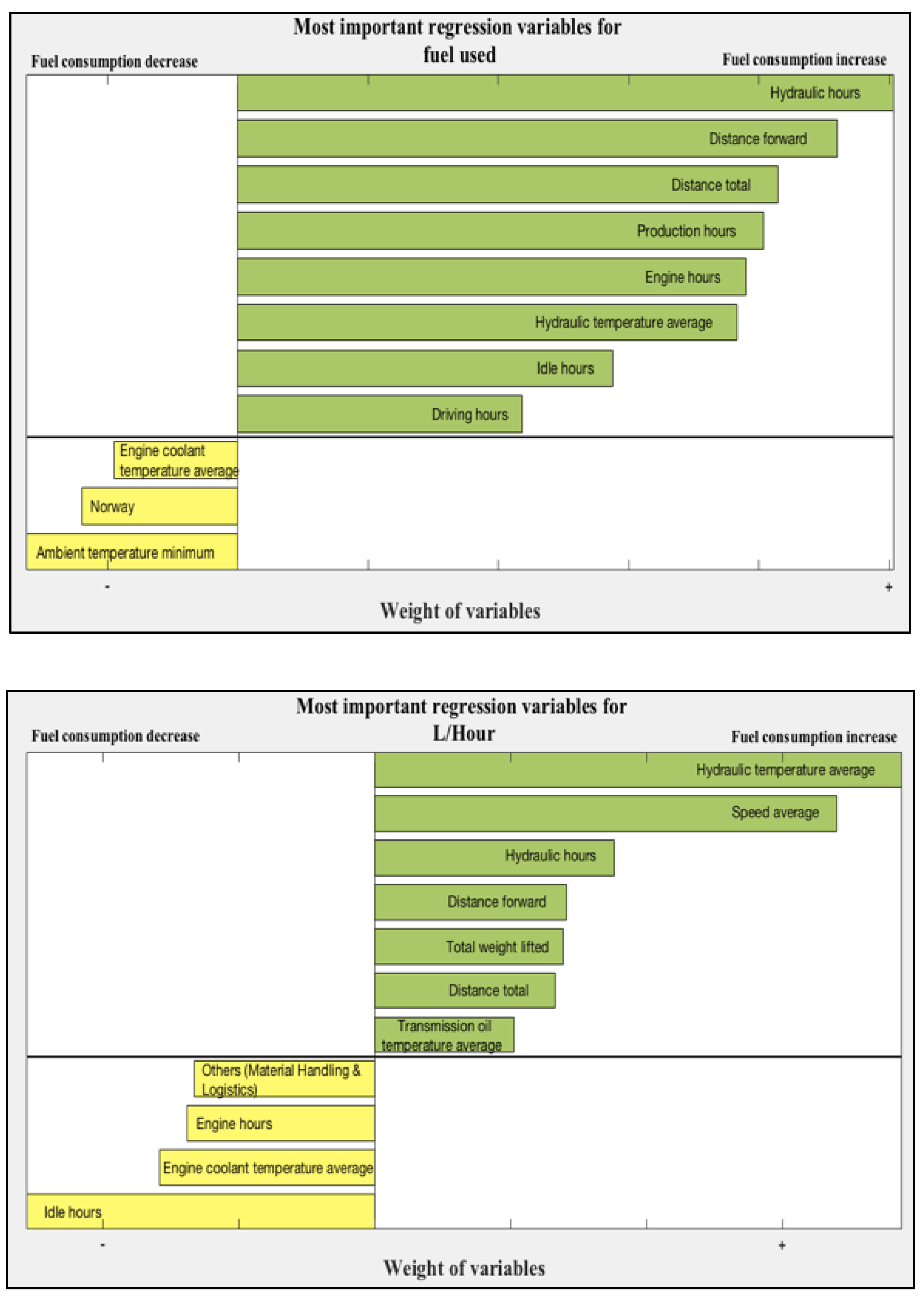
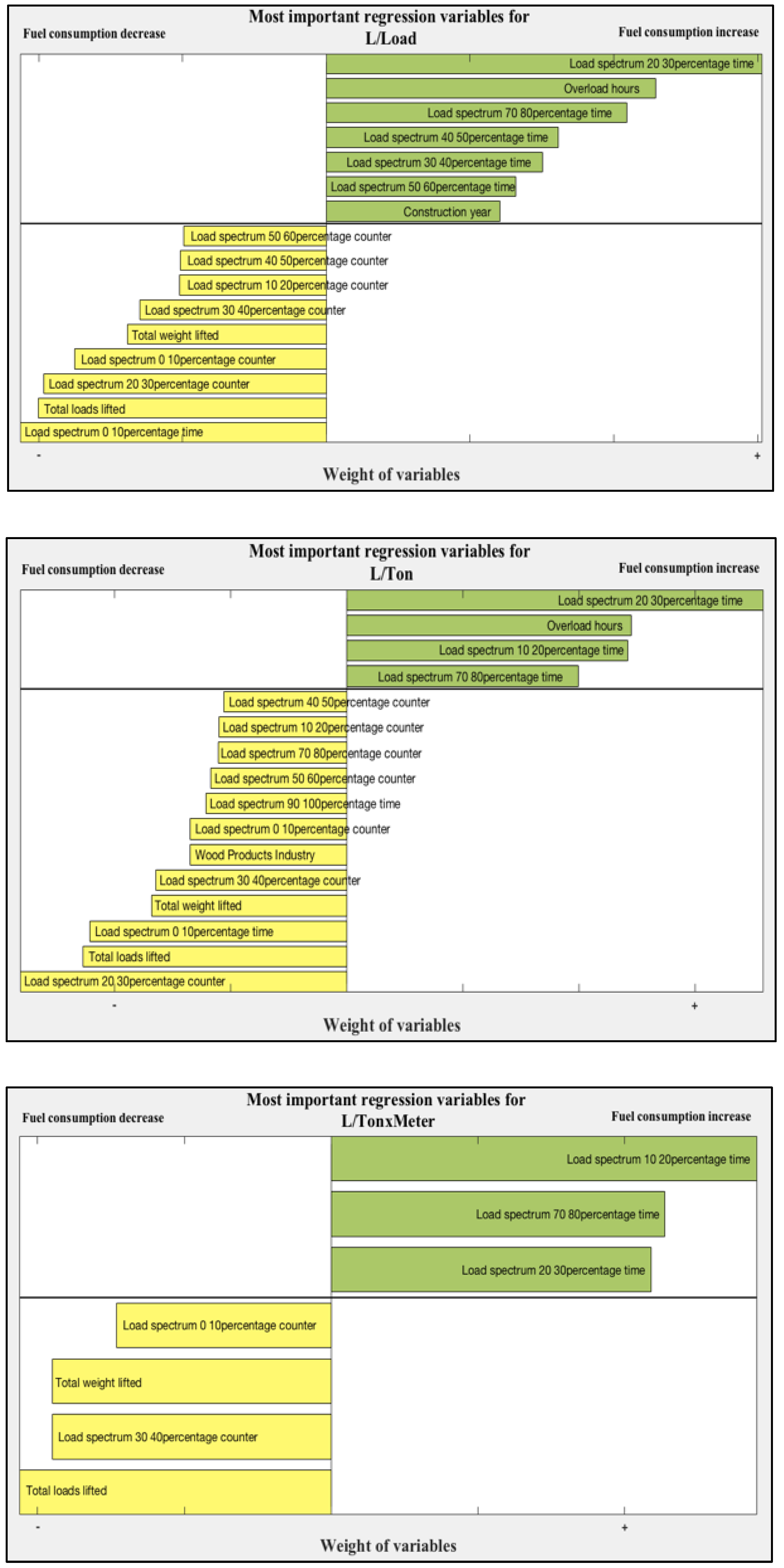
| Categories | Factors |
|---|---|
| Vehicle-related | Vehicle curb weight |
| Vehicle shape | |
| Engine size/type | |
| Engine temperature | |
| Transmission | |
| Fuel type/composition | |
| Oil viscosity | |
| Other characteristics (maintenance, age, accessories, etc.) | |
| Environment-related | Roadway gradient |
| Wind conditions | |
| Ambient temperature | |
| Altitude | |
| Pavement type | |
| Other | |
| characteristics | |
| (humidity, surfaceconditions, etc.) | |
| Travel-related | Speed |
| Acceleration/deceleration | |
| Congestion | |
| Driver-related | Driver aggressiveness |
| Gear selection | |
| Idling time | |
| Operations-related | Fleet size and mix |
| Payload | |
| Empty kilometers | |
| Number of stops |
| Latent Factor | Percentage of Explained Variance for X | Cumulative Percentage of Explained Variance for X | Percentage of Explained Variance for Y | Cumulative Percentage of Explained Variance for Y | Root Mean Squared Error of Prediction |
|---|---|---|---|---|---|
| Liters per day | |||||
| 1 | 16.372 | 16.372 | 90.645 | 90.645 | 12.604 |
| 2 | 5.428 | 21.800 | 2.803 | 93.448 | 10.548 |
| 3 | 3.245 | 25.045 | 1.424 | 94.872 | 9.331 |
| 4 | 2.691 | 27.736 | 0.542 | 95.414 | 8.824 |
| 5 | 2.064 | 29.800 | 0.258 | 95.672 | 8.573 |
| 6 | 2.168 | 31.968 | 0.130 | 95.802 | 8.443 |
| 7 | 2.069 | 34.037 | 0.091 | 95.893 | 8.351 |
| 8 | 2.658 | 36.695 | 0.051 | 95.944 | 8.299 |
| 9 | 2.368 | 39.063 | 0.040 | 95.984 | 8.258 |
| Liters per hour | |||||
| 1 | 15.079 | 15.079 | 24.089 | 24.089 | 1.485 |
| 2 | 7.374 | 22.453 | 21.527 | 45.616 | 1.257 |
| 3 | 4.218 | 26.671 | 5.083 | 50.699 | 1.197 |
| 4 | 3.687 | 30.358 | 3.530 | 54.229 | 1.153 |
| 5 | 2.481 | 32.839 | 2.325 | 56.554 | 1.124 |
| 6 | 1.930 | 34.769 | 1.598 | 58.152 | 1.103 |
| 7 | 1.530 | 36.299 | 1.086 | 59.238 | 1.088 |
| 8 | 2.706 | 39.005 | 0.258 | 59.496 | 1.085 |
| 9 | 1.717 | 40.722 | 0.233 | 59.729 | 1.082 |
| Liters per load | |||||
| 1 | 14.698 | 14.698 | 18.262 | 18.262 | 1.126 |
| 2 | 8.888 | 23.586 | 13.841 | 32.103 | 1.026 |
| 3 | 3.801 | 27.387 | 2.870 | 34.973 | 1.004 |
| 4 | 1.924 | 29.311 | 1.789 | 36.762 | 0.990 |
| 5 | 2.312 | 31.623 | 0.832 | 37.594 | 0.984 |
| 6 | 2.810 | 34.433 | 0.419 | 38.013 | 0.980 |
| 7 | 2.278 | 36.711 | 0.343 | 38.356 | 0.978 |
| 8 | 2.167 | 38.878 | 0.222 | 38.578 | 0.976 |
| 9 | 1.573 | 40.451 | 0.141 | 38.719 | 0.975 |
| Liters per ton | |||||
| 1 | 15.628 | 15.628 | 14.153 | 14.153 | 0.528 |
| 2 | 7.723 | 23.351 | 12.18 | 26.333 | 0.489 |
| 3 | 3.795 | 27.146 | 2.602 | 28.935 | 0.481 |
| 4 | 2.159 | 29.305 | 1.621 | 30.556 | 0.465 |
| 5 | 2.574 | 31.879 | 0.654 | 31.210 | 0.473 |
| 6 | 2.701 | 34.580 | 0.326 | 31.536 | 0.472 |
| 7 | 2.179 | 36.759 | 0.260 | 31.796 | 0.471 |
| 8 | 1.871 | 38.630 | 0.151 | 31.947 | 0.470 |
| 9 | 1.629 | 40.259 | 0.098 | 32.045 | 0.470 |
| Liters per ton-meter | |||||
| 1 | 11.463 | 11.463 | 13.663 | 13.663 | 0.017 |
| 2 | 11.89 | 23.353 | 7.814 | 21.477 | 0.016 |
| 3 | 3.963 | 27.316 | 2.839 | 24.316 | 0.106 |
| 4 | 2.466 | 29.782 | 1.888 | 26.204 | 0.015 |
| 5 | 3.012 | 32.794 | 0.795 | 26.999 | 0.015 |
| 6 | 2.520 | 35.314 | 0.508 | 27.507 | 0.015 |
| 7 | 2.187 | 37.501 | 0.386 | 27.893 | 0.015 |
| 8 | 2.018 | 39.519 | 0.221 | 28.114 | 0.015 |
| 9 | 1.858 | 41.377 | 0.137 | 28.251 | 0.015 |
© 2019 by the authors. Licensee MDPI, Basel, Switzerland. This article is an open access article distributed under the terms and conditions of the Creative Commons Attribution (CC BY) license (http://creativecommons.org/licenses/by/4.0/).
Share and Cite
Pashkevich, N.; Haftor, D.; Karlsson, M.; Chowdhury, S. Sustainability through the Digitalization of Industrial Machines: Complementary Factors of Fuel Consumption and Productivity for Forklifts with Sensors. Sustainability 2019, 11, 6708. https://doi.org/10.3390/su11236708
Pashkevich N, Haftor D, Karlsson M, Chowdhury S. Sustainability through the Digitalization of Industrial Machines: Complementary Factors of Fuel Consumption and Productivity for Forklifts with Sensors. Sustainability. 2019; 11(23):6708. https://doi.org/10.3390/su11236708
Chicago/Turabian StylePashkevich, Natallia, Darek Haftor, Mikael Karlsson, and Soumitra Chowdhury. 2019. "Sustainability through the Digitalization of Industrial Machines: Complementary Factors of Fuel Consumption and Productivity for Forklifts with Sensors" Sustainability 11, no. 23: 6708. https://doi.org/10.3390/su11236708
APA StylePashkevich, N., Haftor, D., Karlsson, M., & Chowdhury, S. (2019). Sustainability through the Digitalization of Industrial Machines: Complementary Factors of Fuel Consumption and Productivity for Forklifts with Sensors. Sustainability, 11(23), 6708. https://doi.org/10.3390/su11236708





